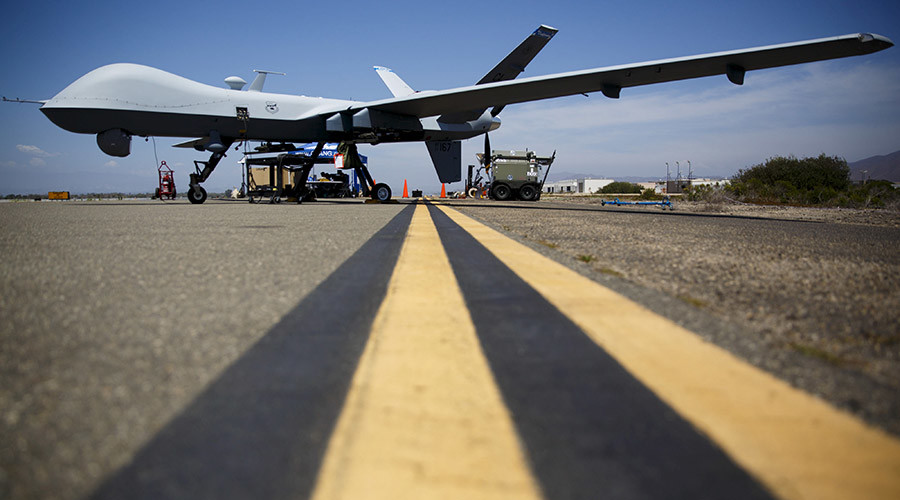It’s Time for Transparency in the US Lethal Drone Program
ANALYSIS, 20 Jun 2016
Rachel Stohl | Bulletin of the Atomic Scientists – TRANSCEND Media Service
16 Jun 2016 – During the Obama presidency, the US drone program has been a topic of significant debate, with critics calling into question the program’s overall efficacy and highlighting the threat lethal drones pose to innocent civilians. Civilian casualties have raised a number of legal and ethical questions regarding use of this technology, particularly outside of active combat zones. Central to this debate is the secrecy surrounding the US lethal drone program, including a lack of official information on casualty figures and accountability for mistakes.
The United States’ drone program has been responsible for more than 500 strikes in numerous countries where the United States is not engaged in active combat—such as Pakistan, Somalia, and Yemen—even though the majority of drone missions overall have been for non-lethal purposes, such as surveillance and reconnaissance. To date, US drone strikes are believed to have resulted in between 500 and 1,000 civilian deaths by some estimates. Estimates of strikes and casualties are all based on unofficial data, as the Obama administration has provided few details on its lethal drone program and has been loathe to acknowledge the extent to which civilians have been injured or killed by US strikes. In a May 2 interview with CNN, Obama commented on increased drone use during his presidency, stating that “It became so easy to use [drones] without thinking through all the ramifications.”
Indeed, the United States’ use of armed drones—particularly the use of armed drones outside Iraq, Syria, and other “areas of active hostilities”—has prompted numerous debates about the ethical and strategic implications of unmanned attacks on perceived threats to the United States and US interests. Central to these debates are questions about how lethal drone strikes will shape the use of force in the future.
Criticism of the drone program has been based largely on the effectiveness of targeting key terrorist leaders, the use of primarily lethal force to combat terrorism, the propensity for blowback and anti-American sentiment, the erosion of sovereignty, and the potential for lowering the threshold for entering conflict—which could lead toward endless warfare and instability. Indeed, a central criticism is that the US program could prompt other countries to adopt similar practices and take unilateral action against perceived threats—action cloaked in secrecy and lacking a declaration of war—thereby setting a dangerous precedent.
Drones are simply platforms that use air-to-surface missiles, such as the Hellfire II, to strike designated targets. These missiles are precise weapons capable of targeting specific individuals. The problems surrounding lethal drone strikes, therefore, are not related to the platform itself—or even to the weapons they fire—but rather stem from the challenges of intelligence collection and use in the United States’ counterterrorism efforts. These challenges may be the consequence of a number of factors, such as an insufficient amount of data, limited data analyses, or a lack of uniform standards for the intelligence required before deciding whether a strike will accomplish desired objectives. The secrecy surrounding the US drone program compounds these challenges and inhibits objective evaluations of the program’s impact and effectiveness.
A Lack of Transparency
The secrecy surrounding the US drone program makes it difficult to undertake assessments about the efficacy of the program and whether the benefits of lethal drones outweigh the risks. These questions are even more pressing as more and more countries seek to adopt similar capabilities for their own security and defense.
Since May 2013, the Obama administration has vowed to be more transparent about its drone program. But for three years, the administration has dragged its heels on fulfilling these commitments. Obama has repeatedly acknowledged the importance of transparency, stating that he recognizes this as “a legitimate concern,” but the administration has yet to make significant progress toward addressing this concern and ensuring that the US program rests on an appropriate framework that will allow for greater transparency, responsibility, and accountability.
At the Nuclear Security Summit earlier this year, Obama defended the US drone program and the processes by which targeting decisions are made. However, the president also acknowledged that criticism of the program—regarding both the lack of transparency and the number of civilian casualties—has, to a certain extent, been fair, stating that “the legal architecture around the use of drone strikes or other kinetic strikes wasn’t as precise as it should have been, and there’s no doubt that civilians were killed that shouldn’t have been.”
Promising to do better, the president said, “We have to take responsibility when we’re not acting appropriately, or where we’ve just made mistakes even with the best of intentions. And that’s what we’re going to continue to try to do.” But is the Obama administration succeeding in this regard? With only a few months left in office, the president’s drone record remains mired in secrecy.
A Poor Report Card
Congressional intelligence committees are able to review lethal drone strikes conducted by the CIA and Department of Defense after they occur, but publicly the administration has been reluctant to acknowledge the use of lethal drones in foreign countries. The Pentagon generally does not provide detailed information on drone operations, and the CIA doesn’t release information on its strikes. As a result, the administration has rarely disclosed information on the approximate number, location, responsible agency, or death tolls of strikes—even in aggregate numbers. To date, only a few documents about the drone program have been released—including two versions of a 2010 Department of Justice memo on the justification for killing US citizen and radical Muslim cleric Anwar al-Awlaki, and a Department of Justice white paper on the legal framework for using lethal force against Al Qaeda leaders—and those were primarily under court order.
In February, the Stimson Center released its drone policy Report Card, which gave an overall grade of D for the administration’s progress toward fulfilling the transparency recommendations of the 2014 Stimson Task Force on U.S. Drone Policy co-chaired by retired General John P. Abizaid, the former head of United States Central Command; and by Rosa Brooks, former counselor to the undersecretary of defense for policy in the Obama administration. The task force called for improving transparency in targeted drone strikes by: acknowledging the use of lethal force in foreign countries, both to Congress and the American public; releasing information on the approximate number of strikes carried out by the military and the CIA (including the general location of strikes, the number of people known to have been killed, the organizational affiliation of those known to have been killed, the number of civilians known to have been killed, and the identities of civilians known to have been killed); and ordering the preparation and public release of a detailed report explaining the legal basis—under both domestic and international law—guiding the US lethal drone program. Unfortunately, few of these steps have yet been taken, despite repeated commitments to do so.
Rooted in Secrecy
On April 8, during remarks at the University of Chicago, Obama argued that the lack of progress in improving transparency surrounding the US drone program is rooted in the development of the program via covert channels, which plagued it from the start, stating:
I think that the way that this got built up through our intelligence and what’s called our Title 50 programs meant that it did not—it wasn’t subject to the same amount of democratic debate as when we are conducting what are called Title 10 Department of Defense conventional operations. And that’s done a disservice not only to the public being able to examine where we made mistakes and create corrective action, it’s actually also done a disservice to the incredibly dedicated men and women in intelligence and in operations who perform these operations who are subject to accusations that somehow they’re irresponsible and bloodless and going around—blowing up children, which is not the case.
To address these concerns, senior administration officials stated in March that the White House intends to work toward greater transparency and release casualty assessments as well as a redacted version of the Presidential Policy Guidance for strikes outside areas of active hostilities. This is a welcome step, but to be effective and meaningful, this information must be publicly available and detailed enough to ensure that an analysis of the US drone program can be undertaken—including the processes through which targeting decisions are made, and the domestic and international legal justifications for these decisions. Casualty assessment data must include information on procedures to conduct post-strike investigations, the criteria used to classify a person as a combatant or a civilian, and the organized armed group to which a deceased individual allegedly belonged. Such data should also disaggregate the data by strike location and date. Finally, the administration should reveal the policies and procedures for compensation/condolence payments when civilians are killed.
Setting the Standard
The release of this information will ensure an analysis about both the costs and benefits of the US drone program and allow for a more informed public debate. It will also allow for a more realistic discussion with US allies and partners about the strategic impacts and implications of continued and expanded drone use, and address questions and concerns about the de facto standard that the United States is setting globally via its lethal drone program. If the Obama administration released this information, it could improve legitimacy by contributing to greater understanding and encouraging evaluation of the US drone program and its overall effectiveness.
The consequences of drone use—the blowback against US personnel and interests, for example—may take decades to materialize. But the use of drones for targeted killings has the potential to shape wars and conflicts in the future, as more countries seek to adopt drone capabilities, without a robust understanding of the potentially negative consequences of secret wars anywhere a country deems necessary. As time runs out for the Obama administration to cement its legacy on drones, the administration must adhere to its commitments for greater transparency and ensure that the US lethal drone program supports strategic interests as well as national values and foreign policy ideals.
_____________________________________
Rachel Stohl is the director of the Conventional Defense program at the Stimson Center, where she leads the Center’s drones project and is the primary author of the recently released report Grading Progress on U.S. Drone Policy.
Go to Original – thebulletin.org
DISCLAIMER: The statements, views and opinions expressed in pieces republished here are solely those of the authors and do not necessarily represent those of TMS. In accordance with title 17 U.S.C. section 107, this material is distributed without profit to those who have expressed a prior interest in receiving the included information for research and educational purposes. TMS has no affiliation whatsoever with the originator of this article nor is TMS endorsed or sponsored by the originator. “GO TO ORIGINAL” links are provided as a convenience to our readers and allow for verification of authenticity. However, as originating pages are often updated by their originating host sites, the versions posted may not match the versions our readers view when clicking the “GO TO ORIGINAL” links. This site contains copyrighted material the use of which has not always been specifically authorized by the copyright owner. We are making such material available in our efforts to advance understanding of environmental, political, human rights, economic, democracy, scientific, and social justice issues, etc. We believe this constitutes a ‘fair use’ of any such copyrighted material as provided for in section 107 of the US Copyright Law. In accordance with Title 17 U.S.C. Section 107, the material on this site is distributed without profit to those who have expressed a prior interest in receiving the included information for research and educational purposes. For more information go to: http://www.law.cornell.edu/uscode/17/107.shtml. If you wish to use copyrighted material from this site for purposes of your own that go beyond ‘fair use’, you must obtain permission from the copyright owner.

